Katie sent me this paper.1 It actually adds an interesting twist to her story that I already published.
She reached out to me last week with her Desaturase Index test results. The test is here. Her score was around a 1.6, which is relatively good and significantly better than where I started out at 2.1. With an index that low, she was able to lose inches fairly easily with The Croissant Diet (TCD). It turns out that a tea she was drinking preceding and during her TCD experiment is a potent SCD1 suppressor! It may have set her up for success.
Here are her thoughts on the matter:
The Tea
Pu-erh tea is a type of fermented tea made in China. It seems that the long fermentation is what gives it the magic that supresses SCD1. I’m not trying to be an expert on tea, so I’ll let Katie continue to tell the story:
The links, BTW, aren’t adds, those are just Katie’s suggestions.
The Science
The science behind the tea is actually pretty impressive. In a study where overweight adults were given Pu’ehr tea without any dietary changes, the test subjects lost a small but statistically significant amount of weight over 20 weeks.2
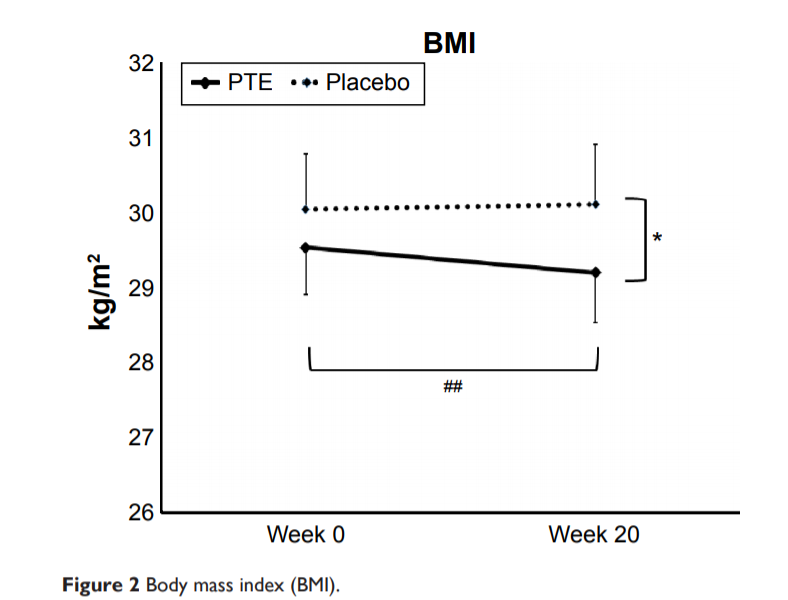
In C elegans worms, a small amount of tea extract caused a large drop in SCD gene expression (called fat6 and fat7 in c elegans) and smaller sizes of stored fat droplets.
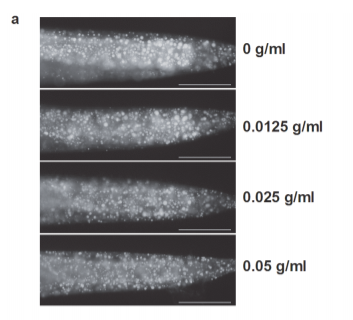
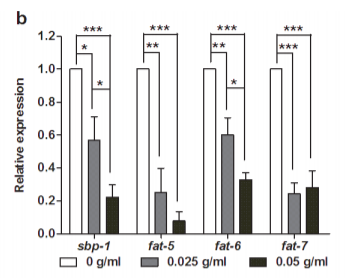
In mice, pu’erh tea actually prevented Western diet induced obesity!3 It suppressed a whole range of genes involved in fat synthesis and storage and increased the expression of genes involved in burning fat (b-oxidation). But it PARTICULARLY suppressed SCD1, dropping it below then levels of control mice on a normal chow diet.
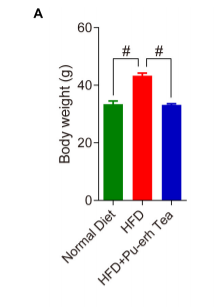
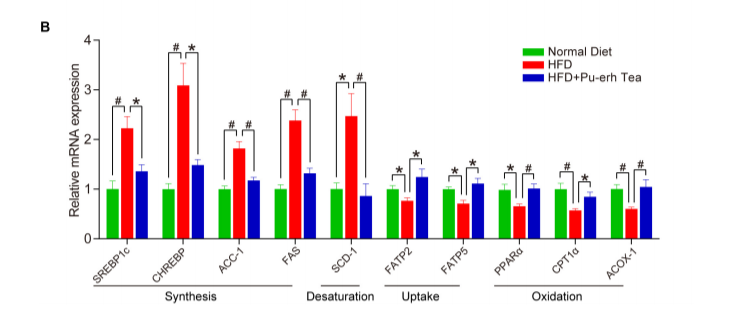
Pretty Cool Tea
In addition to causing weight loss in humans and c elegans and preventing weight gain in Western diet fed mice, the tea is also pressed into blocks and aged as long as ten years. It’s the coolest tea that I know about.
I think that Katie’s instinct on this right. The best way to use the ideas presented in The Croissant Diet and The SCD1 Theory of Obesity is to combine a strategy of consuming a pretty good amount of very highly saturated fat with a strategy to reduce SCD1 levels. This tea is a promising new tool in the toolbox.
- 1.Ding Y, Zou X, Jiang X, et al. Pu-Erh Tea Down-Regulates Sterol Regulatory Element-Binding Protein and Stearyol-CoA Desaturase to Reduce Fat Storage in Caenorhaditis elegans. Yang H, ed. PLoS ONE. Published online February 6, 2015:e0113815. doi:10.1371/journal.pone.0113815
- 2.Jensen G, Beaman J, He Y, Guo J, Sun H. Reduction of body fat and improved lipid profile associated with daily consumption of a Puer tea extract in a hyperlipidemic population: a randomized placebo-controlled trial. CIA. Published online March 2016:367. doi:10.2147/cia.s94881
- 3.Huang F, Wang S, Zhao A, et al. Pu-erh Tea Regulates Fatty Acid Metabolism in Mice Under High-Fat Diet. Front Pharmacol. Published online February 5, 2019. doi:10.3389/fphar.2019.00063

If anyone knows the best place to source this in Ontario Canada please let me know! Davidstea only has sheng pu’erh
Find a tea shop with a good reputation in your area, they will most likely have it or can order it for you. Or check with your local health food store. I’d be careful ordering this online from an unknown source.
Hi Leslie,
I’m from Winnipeg and we have a great local place called tea mate they ship across Canada i believe
https://teamate.ca/collections/pu-erh-tea
Not a shill just love the place 🙂
Hi, which of the 3 options of the test do you recommend?
You have to do the “complete” test to get MUFA and saturated fat which allows you to calculate the Desaturase Index, which is just Oleic acid (18:1) divided by stearic acid (18:0).
Been mulling over what you have been writing here Brad… Since most people who are overweight and have problems losing the weight will have an underlying insulin issue – how would your hypothesis hold up to the thought that saturated fats could cause lipotoxicity, which is then thought to be detrimental to beta cells in the pancreas? Always great to lose the weight, unless it means nuking the pancreas in the process. Your comment that your triglycerides went up after one of your experiments got my attention. So I wonder… I would think that triglycerides increase as fat is released, not just as a response to the carbs. So this could be a two edged sword. Although it would be interesting what your feasting diet labs would look like on a low carb version. Either way, your thoughts on lipotoxicity are appreciated. Thanks.
https://www.frontiersin.org/articles/10.3389/fendo.2018.00384/full
My understanding is that lipotoxicity comes from the unconstrained release of Free Fatty Acids from fat cells. The more saturated the fats are, the more lipotoxic (in a petri dish), but obese people tend to have very unsaturated fat.
Triglycerides are a possible sign of fatty liver or other problems, but I don’t think they cause lipotoxicity, since the fat is safely bound within the VLDL molecules.
Brad
I know most anti-oxidant supplements may be a bad idea in messing with the ROS system. But what about astaxanthin? I’ve read it does not become a negative in high amounts like say beta-carotene or vitamin E would. Thanks
I still don’t love it. I haven’t studied it enough but there is some evidence that carotenes independently upregulate SCD1.
Thanks Brad.
Would you mind tossing this over to Paul Saladino and Peter from hyperlipid for a more thorough debunk? Lipotoxicity seems to be an emerging topic now that high fat diets are gaining a pretty solid footing.
What do you make of this:
Loss of Stearoyl-CoA Desaturase-1 Improves Insulin Sensitivity in Lean Mice but Worsens Diabetes in Leptin-Deficient Obese Mice
https://diabetes.diabetesjournals.org/content/56/5/1228.long
Loss of stearoyl–CoA desaturase-1 function protects mice against adiposity
https://www.pnas.org/content/99/17/11482
It’s an interesting paper. I think there’s a big difference between a mouse that makes zero SCD1 for it’s whole life and a human who has mde too much SCD1 their whole life then lowering it. I can say that the results of this paper don’t parallel my results to date with sterculia oil – I have seen minimal impact on blood glucose or insulin levels, but reduced triglycerides.
Brad
Thank you for this follow up Brad & Katie. I remember hearing on a keto conference that teas could stall weight loss even in keto diets. Reading about ROS theory, it seemed plausible as antioxidants are commonly touted as health draws for tea. I wonder what makes this good for weight loss – is it the puer itself, the potential destruction / oxidation of antioxidants, some magic from the fermentation process, or a combination of factors.
I’d guess it’s some magic from the fermentation.
Brad
https://thechineseteashop.com/collections/pu-erh-teas/ripe-(shou)-pu-erh
How about Pu-erh tea extracts?
Should work the same, I’d guess?
Brad
What about other teas? Matcha, Mate, etc?
I am curious to try Pu-Erh but I typically react negatively to caffeine.
There’s no evidence of a benefit, to my knowledge. It seems to be something specific to Pu-Erh, unfortunately.
Brad
Any idea how much you’d have to drink? I typically drink one cup per day, sometimes two.
My ratio is 1.67, but I don’t know the “slope” of this. In other words, maybe before I started a higher saturated fat diet and drinking the tea, I had a higher value? I only have one sample, unfortunately, taken only a few weeks ago.
I had the same question. How much to drink for the tea to have effect.
Yeah. It’s nice to know how it would effect the ratio over time. I’m surprised at how many are already drinking this! I’d have to dig more into it, but I’m pretty sure that in the human trial it was a single cup of tea per day.
I’m drinking at least 20 oz (591 ml) per day, sometimes more. I was having it sporadically throughout the day, but now that I know it is an SCD1 inhibitor I am targeting it to before meals and also other times throughout the day when I feel like having “something” but that “something” isn’t necessarily a meal.
Is there some kind of maximum time to brew the tea? Could it develop some adverse effects if you brew it too long? Is there a site where I could read up on how to handle this kind of tea in regards of temperature, brewing time, etc.?
Brad,
Given that burning stored PUFA produces lots of toxic products, could the inflammation you had from (possibly) using the sterculia oil be simply the body dealing with these toxic metabolites, and thus temporary as these are flushed out of the body and any damage healed?
If so, then wouldn’t a person have to go through this in order to get to the other side…whether fast or slow…?
Thanks for connecting so many of the dots 😁
Many have suggested that burning fat releases “toxins”, I’m typically skeptical of these kind of non-specific claims.
I’m also quite low on Omega 3 fats and Vitamin D. I’m just now starting a trial of sterculia oil plus DHA and EPA plus Vitamin D to see if that solves the inflammation. But it also may just be a necessary thing to go through. I haven’t noticed any negative effects other than blood tests.
Brad
Hi Brad!
wow! I am a Tee freak, usually black or pu’erh, but with some salt and fat blended in, kind of like tibetan yack butter tea… which is a traditional combination of animal fat and pu’erh tea, and salt, and it seems that it has to be mixed with a highspeed blender, since most tibetans changed from the traditional device (a bamboo tube closed at the bottom, but long with a stick with something just fitting through at the lower end), to highspeed blenders, sometimes even nomadic ones.. so they carry an electricity generator and a highspeed blender..
so I have not looked in to the yack butter, as I could not get any to experiment with.. but at least, these yacks should eat traditionally and natural, and live in harsh conditions, so I imagine the mix could be interesting health wise.. but if that is high saturated and bleded (which I believe changes the uptake or bio availability in some way) with pu’erh, that could be an interesting background and traditional thing to connect to the subject.. LOve David